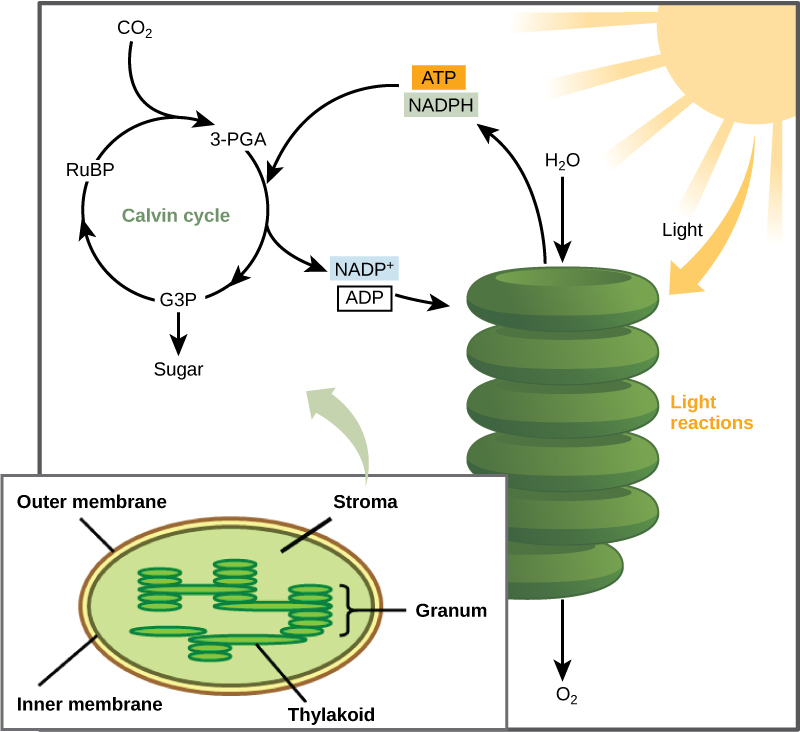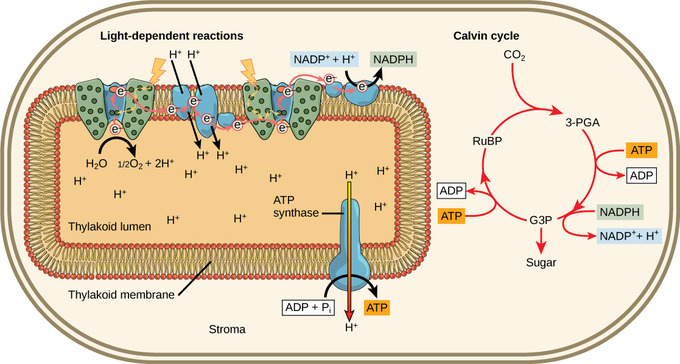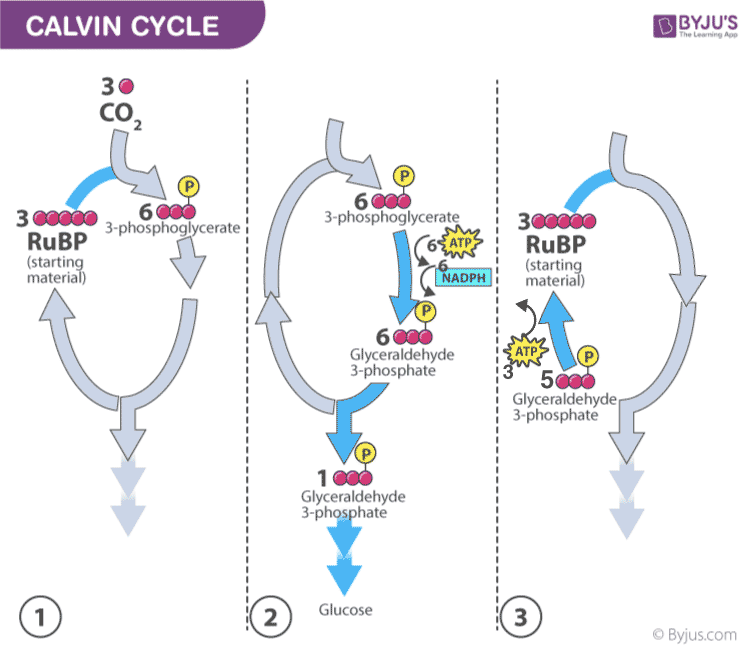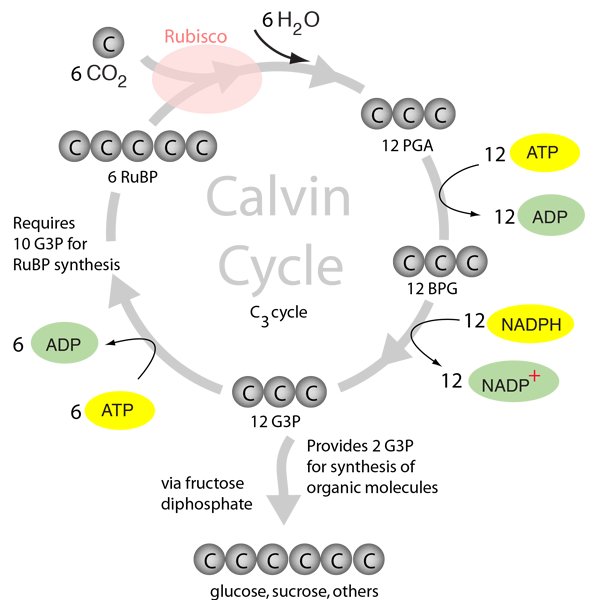|
If you're seeing this message, it means we're having trouble loading external resources on our website. If you're behind a web filter, please make sure that the domains *.kastatic.org and *.kasandbox.org are unblocked. Show
Top 1: The Calvin cycle (article) | Photosynthesis - Khan AcademyAutora: khanacademy.org - 154 Avaliação
Descrição: If you're seeing this message, it means we're having trouble loading external resources on our website. If you're behind a web filter, please make sure that the domains *.kastatic.org and *.kasandbox.org are unblocked.
Resultados de pesquisa correspondentes: This process is fueled by, and dependent on, ATP and NADPH from the light reactions. Unlike the light reactions, which take place in the thylakoid membrane, the ...This process is fueled by, and dependent on, ATP and NADPH from the light reactions. Unlike the light reactions, which take place in the thylakoid membrane, the ... ...
 Top 2: 5.3: The Calvin Cycle – Concepts of Biology – 1st Canadian EditionAutora: opentextbc.ca - 129 Avaliação
Descrição: The Interworkings of the Calvin Cycle. Photosynthesis in Prokaryotes Chapter 5: Introduction to PhotosynthesisLearning ObjectivesBy the end of this section, you will be able to:Describe the Calvin cycleDefine carbon fixationExplain how photosynthesis works in the energy cycle of all living organism
Resultados de pesquisa correspondentes: The Calvin cycle reactions (Figure 5.15) can be organized into three basic stages: fixation, reduction, and regeneration.The Calvin cycle reactions (Figure 5.15) can be organized into three basic stages: fixation, reduction, and regeneration. ...
 Top 3: 5.12C: The Calvin Cycle - Biology LibreTextsAutora: bio.libretexts.org - 201 Avaliação
Descrição: Stage 3: Regeneration . Last updated Save as PDF Page ID9006. The Calvin cycle is organized into three basic stages: fixation, reduction, and regeneration.Learning ObjectivesDescribe the Calvin CycleKey PointsThe Calvin cycle refers to the light-independent reactions in photosynthesis that take pl
Resultados de pesquisa correspondentes: Jan 3, 2021 · The Calvin cycle refers to the light-independent reactions in photosynthesis that take place in three key steps. Although the Calvin Cycle ...Jan 3, 2021 · The Calvin cycle refers to the light-independent reactions in photosynthesis that take place in three key steps. Although the Calvin Cycle ... ...
Top 4: 2.22: Calvin Cycle - Biology LibreTextsAutora: bio.libretexts.org - 188 Avaliação
Descrição: Making Food “From Thin Air”. Carbon Dioxide is “Fixed”. How Does the Calvin Cycle Store Energy in Sugar? . Last updated Save as PDF Page ID6468. Other than being green, what do all these fruits and vegetables have in common?They are. full of energy. Energy in the form of glucose. The energy from su
Resultados de pesquisa correspondentes: Mar 5, 2021 · Each step pushes molecules uphill in terms of energy content. Re ca ll that in the electron transfer chain, excited electrons lose energy to ...Mar 5, 2021 · Each step pushes molecules uphill in terms of energy content. Re ca ll that in the electron transfer chain, excited electrons lose energy to ... ...
 Top 5: An Overview of Calvin Cycle - Stages Of C3 Cycle - Byju'sAutora: byjus.com - 96 Avaliação
Descrição: Calvin Cycle Definition. What is Calvin Cycle?. Key Points on C3 Cycle. Frequently Asked Questions. What is Calvin Cycle?. What are the different steps involved in. the Calvin cycle?. What are the end products of C3 cycle?. What is carbon fixation in the Calvin cycle?. Why is the third step of the Calvin cycle called the regeneration step?.
Resultados de pesquisa correspondentes: May 22, 2020 · Photosynthesis is the biochemical process that occurs in all green plants or autotrophs producing organic molecules from carbon dioxide ...May 22, 2020 · Photosynthesis is the biochemical process that occurs in all green plants or autotrophs producing organic molecules from carbon dioxide ... ...
 Top 6: The Calvin Cycle - HyperPhysics ConceptsAutora: hyperphysics.phy-astr.gsu.edu - 102 Avaliação
Descrição: Click on any part of the diagram for more detail. Plants use energy from the sun in tiny energy factories called chloroplasts. Using chlorophyll in the process of photosynthesis, they convert the sun's energy into storable form in ordered. sugar molecules such as glucose. In this way, carbon dioxid
Resultados de pesquisa correspondentes: In CAM plants the photosynthesis and initial carbon fixation occur at night and a 4-carbon acid is stored in the cell's vacuole. During the day, the Calvin ...In CAM plants the photosynthesis and initial carbon fixation occur at night and a 4-carbon acid is stored in the cell's vacuole. During the day, the Calvin ... ...
 Top 7: Calvin Cycle - an overview | ScienceDirect TopicsAutora: sciencedirect.com - 110 Avaliação
Descrição: CO2 capture by bacteria and their enzymes. Biofixation of carbon dioxide (CO2) by microorganisms. Resource Use Efficiency. Metabolic engineering approaches for high-yield hydrocarbon biofuels. Challenges in industrialization of biological CO2 capture. Agricultural and Related Biotechnologies. “Bioplastics from microalgae”—Polyhydroxyalkanoate production by cyanobacteria. Analysis, fate, and toxicity of engineered nanomaterials in plants. Microalgae-based wastewater treatment and utilization of microalgae biomass. b Partitioning of Nutrient within Assimilatory Pathway. 9.6 Bioconversion of CO2 to hydrocarbons. 19.2.1.1 Reductive pentose pathway or. Calvin-Benson-Bassham (CBB) pathway or Calvin cycle. 4.14.2.1 Photosynthetic Variants in Vascular Plants. 22.4.3 Other storage compounds produced by cyanobacteria in parallel with PHA biosynthesis. 3 The effects of ENMs on photosynthesis.
Resultados de pesquisa correspondentes: Carbon in CO2 is thus said to be more oxidized, while carbon in a carbohydrate is more reduced. The Calvin Cycle does not directly utilize light energy, but is ...Carbon in CO2 is thus said to be more oxidized, while carbon in a carbohydrate is more reduced. The Calvin Cycle does not directly utilize light energy, but is ... ...
|

Postagens relacionadas
Publicidade
ÚLTIMAS NOTÍCIAS
Publicidade
Populer
Publicidade

direito autoral © 2024 cumeu Inc.




























